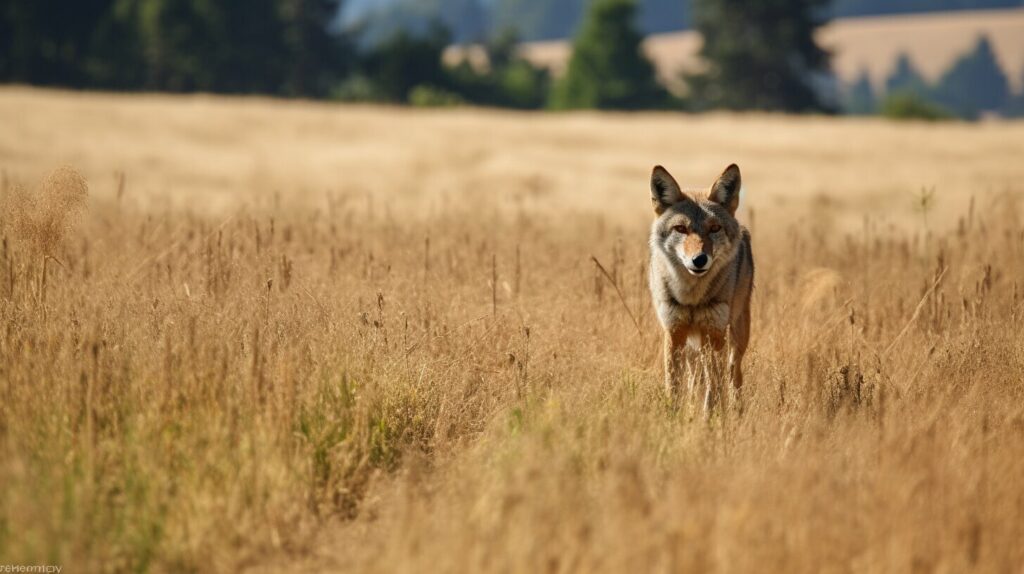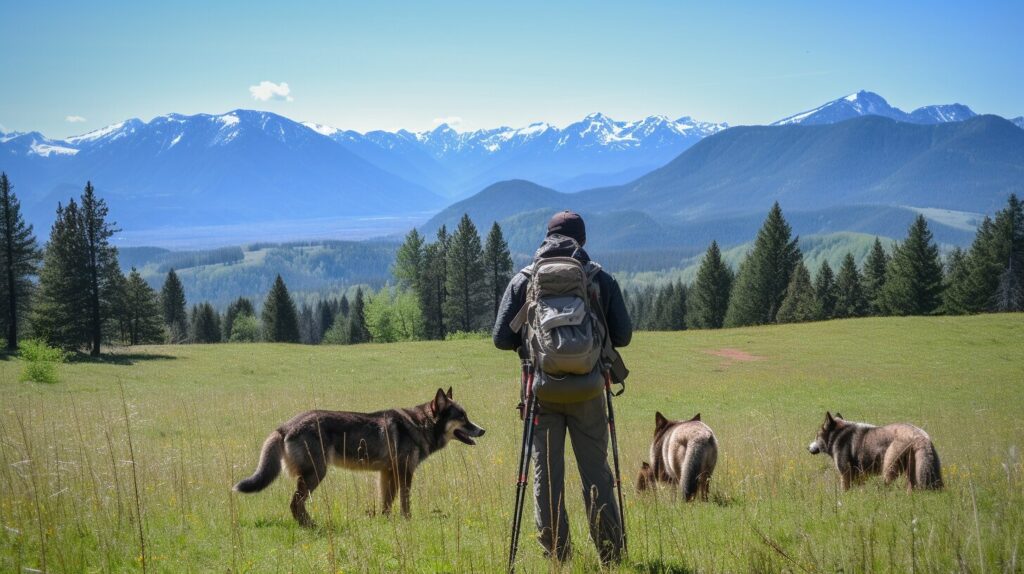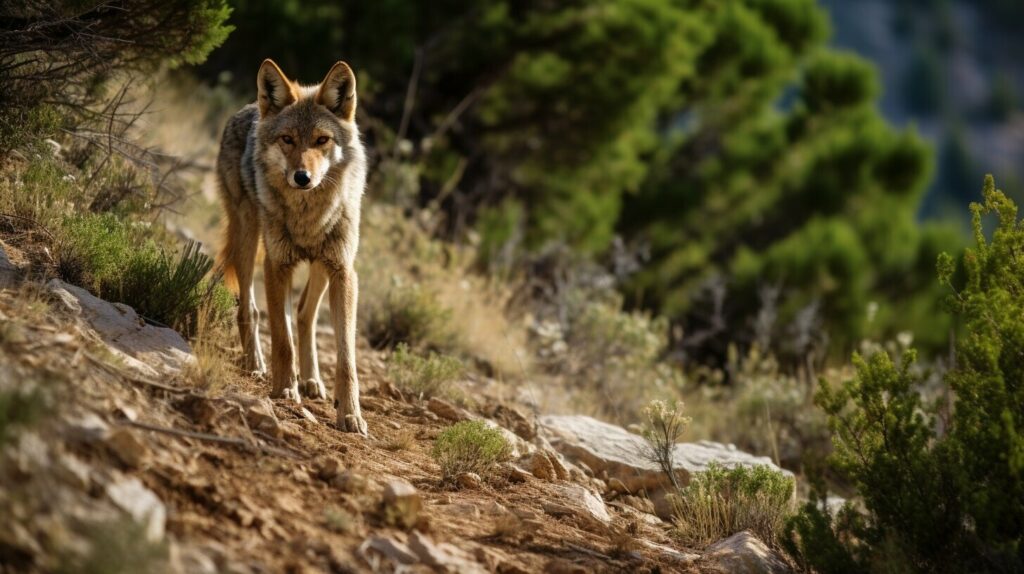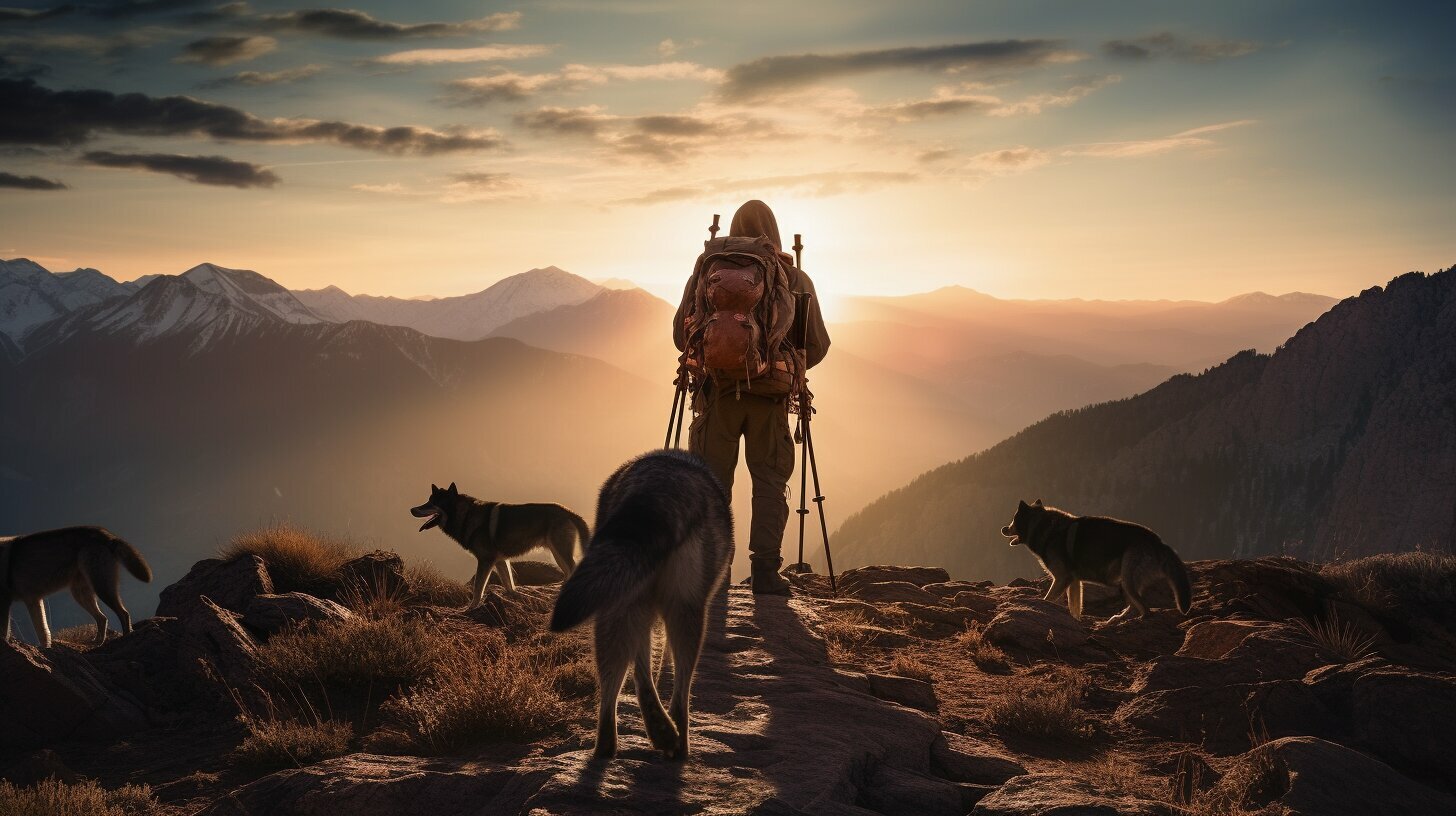Spending time in nature can be an enriching experience, but it’s essential to prioritize your safety, especially when it comes to encountering wildlife. Among the many creatures you might encounter in the great outdoors, coyotes are particularly prevalent, and it’s vital to know how to respond if you come across one.
In this article, we’ll guide you through understanding coyote behavior, providing preventive measures to minimize risk, and techniques for handling various encounter scenarios. We’ll also provide a step-by-step guide on what to do in a coyote encounter, so you can stay safe and enjoy your time exploring nature.
Key Takeaways
- Encountering coyotes in nature is common, but it’s essential to prioritize your safety.
- Understanding coyote behavior and characteristics can help you handle encounters effectively.
- Preventive measures are key to minimizing the risk of encountering coyotes.
- Knowing specific techniques for handling coyote encounters can help you respond safely and confidently.
- A step-by-step guide on what to do in a coyote encounter is provided to ensure your safety.
- Various strategies for dealing with coyote encounters are available, including how to deter coyotes, handle encounters when walking or hiking with others, and report aggressive coyote behavior to authorities.
Understanding Coyote Behavior and Characteristics
Before you head out into nature, it’s important to understand the behavior and characteristics of coyotes. Coyotes are typically found in North America, and they are known for being opportunistic and adaptable animals. They are often seen in urban areas, parks, and other outdoor environments.
Coyotes are usually nocturnal animals, and they are more active during dawn and dusk. They thrive on small mammals, such as rodents and rabbits, but they may also feed on fruits and insects. Coyotes are generally shy and elusive creatures, but they may display aggressive behavior if they feel threatened or are protecting their pups or territory.
Disclosure: When you buy through links on our site, we may earn an affiliate commission.
Common Signs of Coyote Presence
It’s important to be aware of the signs of coyote presence to avoid any unwanted encounters. Some common signs to look out for include:
- Tracks
- Droppings
- Howls or yips
- Coyote dens
If you do come across a coyote, it’s important to remain calm and avoid any sudden movements. Coyotes are more likely to flee if you make yourself appear big and loud by raising your arms and making noise.
What to Do if You Encounter a Coyote
If you encounter a coyote, it’s important to stay calm and use caution. Avoid turning your back on the coyote or running away, as this may trigger a chase response. Instead, stand your ground, make yourself appear big and loud, and slowly back away while facing the coyote.
If the coyote approaches you, try to intimidate it by yelling, clapping, or using a whistle. If the coyote continues to approach, throw rocks or use a stick to scare it away.

Remember, coyotes are wild animals and should be treated with respect and caution. By understanding their behavior and taking precautions, you can minimize the risk of encountering a coyote and stay safe in nature.
Coyote Safety Tips: Prevention is Key
To ensure your safety in coyote encounters, it is crucial to take preventive measures. Here are some practical tips you can follow to minimize the risk of encountering coyotes:
| Tips | Description |
|---|---|
| Do not feed coyotes | Coyotes are naturally wary of humans but may become bolder if they associate people with food. Do not leave pet food outside, clean up fallen fruit from trees, and secure garbage cans. |
| Keep pets leashed | Keep your pets on a leash when walking them in parks or other areas where coyotes may be present. Also, do not allow pets to roam free in areas where there may be coyotes. |
| Stay alert | Stay aware of your surroundings and keep a lookout for coyotes. If you see one, do not approach it. Instead, back away slowly and calmly. |
| Make noise | Coyotes are more likely to avoid human encounters if they hear noise. Make noise by talking loudly, clapping your hands, or using a whistle. This will alert the coyotes to your presence and encourage them to stay away. |
| Protect your property | If you live in an area where coyotes are present, install fencing around your property and close off any crawl spaces or gaps that may provide access to coyotes. |
| Be prepared | Carry a whistle or air horn with you on walks and hikes. In the event of a coyote encounter, these tools can help scare off the animal. |
By following these simple steps, you can create a safer outdoor environment for yourself and your pets, minimizing the risk of encountering coyotes.

Remember, prevention is key to staying safe in coyote encounters.
Techniques for Surviving Coyote Encounters
If you find yourself in a coyote encounter, there are several techniques you can employ to stay safe and minimize the risk of harm. Here are some strategies to keep in mind:
- Stay calm: If you encounter a coyote, it’s important to stay calm and avoid panicking. This will help you think clearly and respond appropriately to the situation.
- Stand your ground: Coyotes are typically more afraid of humans than we are of them. Stand tall and make yourself look as big as possible by raising your arms and holding your jacket or backpack above your head. Maintain eye contact with the coyote and back away slowly, avoiding turning your back on the animal.
- Make noise: Coyotes are often scared off by loud noises. Carry a whistle, air horn, or other noise-making device with you when hiking or walking in areas where coyotes may be present. Use it to scare off any coyotes that approach you.
- Throw objects: If a coyote continues to approach you, throw small objects like sticks, rocks, or sand in its direction. This can help scare off the animal without causing harm.
- Consider carrying deterrents: There are several non-lethal deterrents you can carry with you in case of a coyote encounter, including pepper spray and bear spray. These can be effective at deterring aggressive coyotes and preventing harm.
Remember:
While it’s important to take precautions when encountering coyotes, it’s also important to remember that they are a natural part of the ecosystem and play an important role in maintaining balance in the environment. By following these techniques for surviving coyote encounters, you can coexist safely with these fascinating animals and enjoy the great outdoors with confidence.

What to Do in a Coyote Encounter: A Step-by-Step Guide
Encountering a coyote can be a frightening experience, but knowing how to react can make all the difference. Here are the steps to take when you encounter a coyote:
- Stay Calm: The first and most important step is to stay calm. Coyotes are generally not aggressive towards humans, and they will usually run away if they feel threatened.
- Make Yourself Big: If the coyote is still nearby, make yourself look as big as possible by standing tall, raising your arms, and opening up your jacket. This will make you appear larger and more intimidating.
- Make Noise: If the coyote is still approaching you, make loud noises by clapping your hands, shouting, or using a whistle. The goal is to scare the coyote away.
- Back Away Slowly: While making noise, slowly back away from the coyote. Do not turn your back on the coyote or run, as this can trigger the coyote’s prey drive.
- Throw Objects: If the coyote continues to approach you, throw objects towards the coyote’s feet (not at its head). This can startle the coyote and may cause it to back away.
- Spray with Water: If you have a water bottle or hose, you can also spray the coyote with water. This can be an effective deterrent.
- Use Pepper Spray: If the coyote is still not deterred, you can use pepper spray as a last resort. Spray the coyote in the face and eyes, and then back away slowly.
- Report the Encounter: Finally, report the encounter to your local wildlife agency or animal control. This will help them keep track of coyote activity in your area and may prevent future encounters.
Remember, coyotes are a natural part of the environment and it’s important to coexist with them safely. By following these steps and understanding coyote behavior, you can stay safe and prevent potentially dangerous encounters.

Coyote Safety Tips: Prevention is Key
While it’s important to know how to handle a coyote encounter, the best strategy is to prevent them from happening in the first place. Here are some practical tips to keep in mind:
- Don’t feed the coyotes: Feeding coyotes can cause them to lose their natural fear of humans, making encounters more likely. Keep your food and garbage secured when in outdoor areas.
- Keep your pets on a leash: Coyotes may view dogs as a threat and could become aggressive towards them. Keep your pets on a leash and under your control at all times.
- Avoid walking alone: Coyotes are less likely to approach a group of people than someone who is alone. If possible, walk or hike with a partner or group.
- Be aware of your surroundings: Keep an eye out for signs of coyote activity, such as tracks, droppings, or howling. If you see or hear a coyote, leave the area immediately.
- Secure your property: Coyotes can be drawn to residential areas by sources of food, such as bird feeders or unsecured garbage cans. Take steps to secure your property and eliminate potential food sources.
By following these tips, you’ll reduce your risk of encountering a coyote and help keep both yourself and the wildlife safe. Remember, prevention is key!

Coyote Encounters: Staying Safe in Nature
Coyotes are fascinating creatures but encountering them in the wild can be unsettling. However, with the right knowledge and techniques, you can stay safe while coexisting with these animals.
Follow these tips to stay safe during coyote encounters:
Be alert: Keep an eye out for coyotes and keep your pets leashed or secured. Coyotes are more active at dawn and dusk, so be especially cautious during these times.
Make noise: Making noise while walking or hiking helps alert coyotes to your presence, giving them time to avoid you. Sing, talk, or carry a bell.
Don’t feed coyotes: Feeding coyotes can create unhealthy dependencies and habituation, making coyotes lose their natural fear of humans, which can result in aggressive behavior.
Back away slowly: If a coyote approaches you, don’t panic. Stand tall, wave your arms, and make loud noises. If it doesn’t retreat, back away slowly while maintaining eye contact. Do not run; this can trigger a coyote’s instinct to chase.
Report aggressive behavior: If a coyote exhibits aggressive behavior, such as approaching humans or pets without fear, report it to local authorities immediately.
Remember, prevention is key. Here are some measures to prevent coyote encounters:
Secure trash cans: Coyotes are opportunistic feeders and are attracted to easily accessible food sources like trash cans. Make sure your trash cans are secure and inaccessible to coyotes.
Close off areas under decks and sheds: Coyotes can use these areas as dens and hiding spots, so make sure they are closed off or secure.
Install motion sensor lights: Coyotes are nocturnal and avoid well-lit areas. Install motion sensor lights to deter them from approaching your property.
Use scare tactics: Use scare tactics like flashing lights, loud noises, or water hoses to encourage coyotes to leave your property.
By following these tips, you can safely enjoy the outdoors while coexisting with coyotes. Remember, it’s important to prioritize your safety while respecting the natural habitat of these animals.
FAQ
Q: What should I do if I encounter a coyote?
A: If you encounter a coyote, it’s important to remain calm. Make yourself look bigger by raising your arms or waving a jacket. Back away slowly and avoid turning your back on the coyote.
Q: Are coyotes dangerous?
A: Coyotes are generally not dangerous to humans. However, it’s important to remember that they are wild animals and should be treated with caution. It’s best to keep your distance and avoid approaching or feeding them.
Q: How can I prevent coyote encounters?
A: To prevent coyote encounters, make sure to secure your garbage cans, remove any potential food sources from your property, and keep small pets indoors or closely supervised when outside. Additionally, consider installing motion-activated lights or using deterrents, such as loud noises or water sprays, to discourage coyotes from approaching.
Q: What should I do if a coyote approaches my pet?
A: If a coyote approaches your pet, it’s important to prioritize your pet’s safety. Keep your pet on a leash and try to scare the coyote away by shouting, clapping, or making loud noises. If necessary, pick up your pet and back away slowly.
Q: How can I report aggressive coyote behavior?
A: If you encounter aggressive coyote behavior, such as a coyote acting aggressively towards humans or pets, it’s important to report it to local authorities. Contact your local animal control or wildlife management agency to provide them with the details of the encounter.




